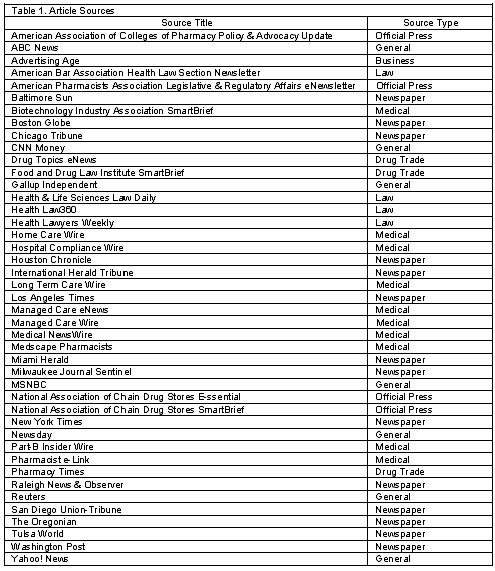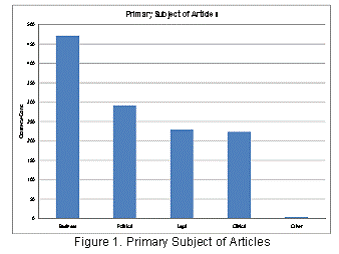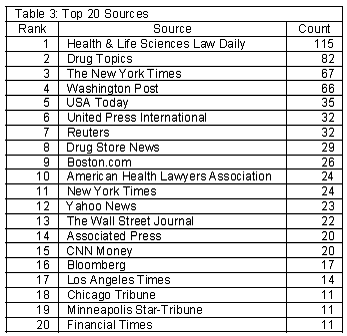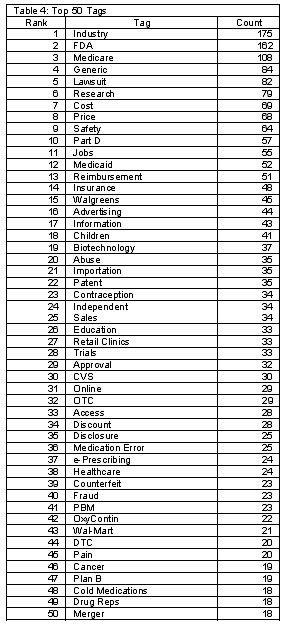Mi SciELO
Servicios Personalizados
Revista
Articulo
Indicadores
-
 Citado por SciELO
Citado por SciELO -
 Accesos
Accesos
Links relacionados
-
 Citado por Google
Citado por Google -
 Similares en
SciELO
Similares en
SciELO -
 Similares en Google
Similares en Google
Compartir
Pharmacy Practice (Granada)
versión On-line ISSN 1886-3655versión impresa ISSN 1885-642X
Pharmacy Pract (Granada) vol.8 no.4 Redondela oct./dic. 2010
ORIGINAL RESEARCH
Educational innovations: categories of bulletin board postings designed to increase awareness of contemporary pharmaceutical policy issues
Innovaciones educativas: categorías de comunicaciones en un tablón de noticias diseñadas para incrementar el conocimiento de problemas contemporáneos de política farmacéutica
Jacob T. Painter 1, Joseph L. Fink III2
1. PharmD, MBA. Schutte Fellow in Pharmaceutical Outcomes and Policy. Department of Pharmacy Practice and Science, University of Kentucky College of Pharmacy. Lexington, KY (United States).
2. BSPharm, JD. Professor of Pharmacy Law and Policy. Department of Pharmacy Practice and Science, University of Kentucky College of Pharmacy. Lexington, KY (United States).
ABSTRACT
Objective: The goal of this project was to categorize and classify bulletin board postings pertaining to pharmaceutical policy from both the professional and lay press.
Methods: Bulletin board postings were used to supplement in-class discussion to keep students, faculty and staff up-to-date on emerging trends. A bulletin board located in the main classroom area of the College of Pharmacy Building where students would pass by on the way to class and congregate during break periods was used to display articles from various sources concerning topics related to pharmaceutical policy. Information is presented about the primary subject matters addressed in the articles, the types of publications from which they were drawn, and the top ten sources of articles displayed.
Results: This project showed that coverage of issues related to pharmacists is predominantly seen in newspapers and most pertinent issues are business related.
Conclusions: It can be seen from this analysis that the issues facing pharmacists are varied. The pharmaceutical policy field is transforming and many of these changes are very relevant to the general population. This is seen from the coverage of all of these issues in the lay press.
Key words: Mass Media. Education, Pharmacy. Public Policy. United States.
RESUMEN
Objetivo: El objetivo de este proyecto fue clasificar y categorizar las comunicaciones de un tablón de noticias sobre política farmacéutica tanto de la prensa profesional como lega.
Métodos: Se usaron comunicaciones en un tablón de noticias para apoyar la discusión en clase y mantener actualizados a los estudiantes, profesores y personal sobre asuntos emergentes. Para mostrar artículos de varias fuentes relativos a asuntos relacionados con la política farmacéutica, se utilizó un tablón de anuncios colocado en la zona de aulas principal del edificio de la Facultad de Farmacia, donde los alumnos pasan camino a las clases y se congregan durante los tiempos de descanso. Se presenta información sobre los principales materias tratadas en los artículos, tipos de publicaciones donde aparecieron y las 10 principales fuentes de los artículos mostrados.
Resultados: Este proyecto mostró que la cobertura de los asuntos relativos a farmacéuticos aparece principalmente en los periódicos y los asuntos más prevalentes son relativos al negocio.
Conclusiones: Puede verse en el análisis que los temas que encaran los farmacéuticos son variados. El campo de la política farmacéutica se está transformando y muchos de esos cambios son muy relevantes a la población en general. Esto puede verse en la cobertura de todos estos asuntos en la prensa lega.
Palabras clave: Medios de difusión. Educación, Farmacia. Política. Estados Unidos.
Introduction
Pharmacy is a very dynamic profession with policies from many sources impacting professional activities.1-3 Government agencies as well as private entities such as insurance companies and certification boards consider and adopt a wide variety of policies that affect pharmacists, pharmacies and pharmaceuticals. Keeping abreast of trends and developments in this broad area can be challenging, even for those whose professional or academic interest lies in these fields. For pharmacy students, with the many and varied demands on their time, this can be even more challenging. Indeed, for these aspiring pharmacists many of the policy issues may be totally new and a facet of pharmacy to which they had limited exposure prior to starting their professional studies. Academic pharmacy continues to be faced with covering an ever-expanding breadth of material to discuss and explore in the same allocation of curricular time. Perhaps nowhere is this more pronounced than with the dynamic and rapidly evolving field of pharmaceutical policy.
The bulletin board initiative
Bulletin board postings can be used to supplement in-class time to keep students, faculty and staff up-to-date on emerging trends. Faculty members of the Pharmaceutical Outcomes and Policy graduate program in the Department of Pharmacy Practice and Science at the University of Kentucky College of Pharmacy adopted a bulletin board located in the main classroom area of the College of Pharmacy Building. The bulletin board was used to display articles from various sources concerning topics related to pharmaceutical policy. One of the intentions of this educational initiative was to publicize to those passing by, especially pharmacy students, the wide range of issues appropriate for consideration as part of the new Ph.D. program in Pharmaceutical Outcomes and Policy being implemented at the College of Pharmacy. Another goal was to provide insight to faculty and staff at the College about contemporary issues in pharmacy.
In concept this is somewhat parallel to the monthly column "Hospital Pharmacy Pulse" appearing in the periodical Hospital Pharmacy. The subtitle descriptor of that column is "Recent Publications on Medicine and Pharmacy."
Similar approaches to education exist in various healthcare and educational forums. Stein illustrates the use of a similar approach for nursing continuing education where time constraints are similar to those experienced by professional students.4 Students and practitioners may also find similarities in this bulletin board process and poster presentations in both aim and approach.5
A faculty member (JLF) reviewed electronic newsletter and other electronic source articles on a daily basis. This task had a minimal marginal time commitment (approximately 15 minutes per day) because the sources were already being reviewed on a daily basis to keep abreast to developments. Those of importance and interest were printed off and displayed on the bulletin board for an entire semester, newer entries being placed on top of the older ones. This approach kept the most recent items in view while preserving access to more dated ones. Sources of materials are listed in Table 1.

Challenges existed with some sources. For example, the website for Forbes was limited in a way that news articles could not be printed off. Additionally, the Wall Street Journal required a subscription to gain access to articles for printing off. When such impediments were encountered alternative sources of articles on the same topic were identified. This was accomplished by using search engines keyed to the topic and date of the unprintable item. In terms of U.S. copyright law, the fact that firms doing Internet postings include a "print" button with their articles may be viewed as consent to copy.
Articles were posted by punching two holes in the top of the sheet using a two-hole punch. T-pins were used to mount the articles on the board because they protrude out from the bulletin board and, consequently, have a large capacity.
The bulletin board space used for displaying the articles was 2.5 feet wide by 4 feet high. The postings were arranged in a configuration that had four items across each row with three rows.
Initially consideration was given to using black ink exclusively when printing off the items because that would be less expensive but use of color on the posted items enlivens the presentation and beckons passersby to read the items. One other decision made early on was that the display should strive for fair balance - items on topics of interest would be posted irrespective of whether they were positive or negative toward pharmacy and pharmacists. After three semesters of experience with this initiative a review of the various items being posted was deemed appropriate, even interesting.
Methods
This study examined articles posted from inception of the program, in January 2007, to June 2008. The articles were entered into a custom Microsoft Access database, which divided them according to the following criteria: Source (Professional Literature, Drug Trade, Medical News, Newspaper); Subject Matter (Legal, Clinical, Business, Political, Other) Keywords; Semester Posted; and Impact Radius (International, National, Regional, Local).
In total 1225 articles were examined. A Doctor of Pharmacy candidate performed data collection, which involved qualitative evaluation of each article individually for the abovementioned criteria. Analysis was performed within Microsoft Access and Microsoft Excel to measure the frequency of Keywords, Sources, Subject Matter, and Impact Radii mentioned in the articles.
Results
The numbers of articles and total pages posted on the bulletin board during the three semesters under study here can be seen in Table 2. Analysis of various fields from the database revealed several findings. As seen in Figure 1, Business-related items represented 39% of the articles surveyed versus 24% Political, 18% Legal, 18% Clinical, and 1% Other. This supports Table 4, which shows Industry as the most mentioned keyword throughout the articles. Other keywords supporting this business focus are Generic, Price (typically referring to drug prices), Jobs, Walgreens, Advertising, and Biotechnology. As shown in Figure 2, newspapers are the most cited sources, making up 37% of all articles surveyed. This number is actually deflated, as newspapers originally posted many of the articles classified as Pharmacist eLink or Regional Web. Looking at the Table 3, three of the top ten are newspapers and one is a regional website affiliated with a newspaper.





Table 4 provides the best pulse for what issues are affecting pharmacists in the realm of pharmaceutical policy. Not surprisingly, keywords representative of the most important pharmaceutical stakeholders are prominent (Industry, FDA, Generic, Research, Independent). Other important tags represent important insurance issues our nation is facing (Medicare, Part D, Medicaid, Reimbursement, Insurance). Safety issues are also very important (Safety, Children, Abuse, Medication Error, OxyContin, Cold Medications). A few companies made the list (Walgreens, CVS, Wal-Mart). Finally some miscellaneous issues pertinent to the pharmacy community were included (Research, Information, Importation, Patent, Contraception, Education, Retail Clinics, e-Prescribing).
Discussion
Using electronic sources had the advantage that if one does not have an opportunity to view an email newsletter one day to seek relevant items of interest it will still be there the next day for review. That may lead to the question - Why not forward the item in electronic form to the students? There are several reasons that approach was considered but eschewed. There would be too much volume of material coming into a student´s email in-box and those materials would be too easily deleted. Also, not all would be of interest to everyone, whereas a person standing in front of the bulletin board display can quickly scan all items to select those of interest. Finally, students can be referred to flip back to earlier items if all remain posted for a semester.
An additional advantage of adopting this approach to disseminating contemporary information is that it forces the faculty member to keep abreast of developments as part of screening items for posting on a daily basis. This daily approach is important; posting something new every day means a reader will likely see a new item and that entices the reader to return frequently.
Faculty members have to deal with information overload. How can a balance be struck between the historical or traditional information students need to know with information about highly contemporary trends? How can we get to the students everything they need to know, especially in the fast-paced realm of pharmaceutical policy where important developments occur daily? The challenge of having insufficient time for discussion in the classroom setting of the nuances of evolving trends and their implications for the profession led to exploration of alternative approaches. The use of bulletin board postings to increase students´ awareness of contemporary pharmaceutical policy issues is one approach.
Conclusions
It can be seen from this analysis that the issues facing pharmacists are varied. As seen from the coverage of these varied issues in the lay media, the pharmaceutical policy field is transforming, and many of these changes are very relevant to the general population. The bulletin board project is an important learning tool for pharmacy students as it highlights the importance of staying abreast with important issues about which any pharmacist could be questioned.
Conflict of interest
Authors of this manuscript have no conflicts of interest to disclose concerning possible financial or personal relationships with commercial entities that may have a direct or indirect interest in the subject matter of this manuscript.
External funding: This project was completed without the use of external funding.
Adapted from a poster presentation during the 156th American Pharmacists Association Annual Meeting, San Antonio, TX. April 3-6, 2009.
References
1. Manasse HR Jr, Speedie MK. Summmary: Pharmacist, pharmaceuticals and policy issues shaping the work force in pharmacy. Am J Health Syst Pharm. 2007;64:1292-1293. [ Links ]
2. Zellmer WA, Thompson KK. Why professional policies matter. Am J Health Syst Pharm. 2009;66:997. [ Links ]
3. Fink JL III, Talbert J, Blumenschein K. Policy degree options for pharmacists interested in careers in the health care field. Hospital Pharm. 2010;45:135-141. [ Links ]
4. Stein DL. Bulletin Board Basics. J Contin Educ Nurs 2009;40(10):440-441. [ Links ]
5. Rowe N, Illic D. What impact do posters have on academic knowledge transfer? A pilot survey on author attitudes and experiences. BMC Med Educ. 2009;8;9:71. [ Links ]
Received: 28.05.10
Accepted: 19.09.10














